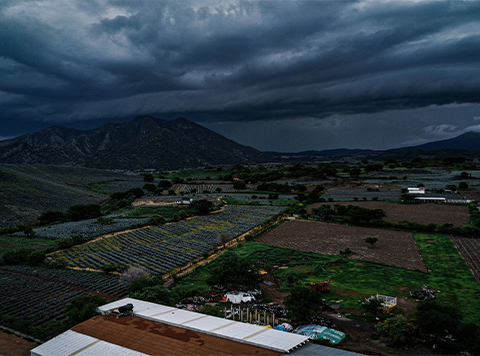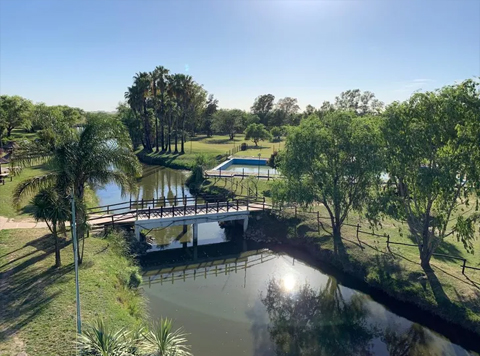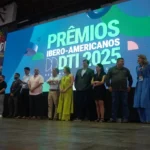
Ganadores Premios Ibearoamericanos DTI 2025
28 abril, 2025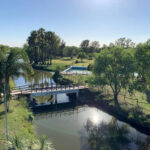
Carmen de Areco: Inteligencia Turística desde lo Local. El desafío y la potencia de ser un destino emergente
14 julio, 2025Abstract
The tourism sector has shown diversification of trends in response to the profile of the new tourist and their travel motivations. This scenario includes interaction with information and communication technologies (ICT) in the different stages of the trip and the search for unique experiences in magical and incomparable destinations, promoting innovation in the intelligent management of destinations. This research aimed to demonstrate the effects on tourism supply and demand in the Magical Town (MT) of Tequila, Jalisco, Mexico, before and after the implementation of the Smart Tourism Destination (STD) model, since this destination presents inno-vation in its management and contributes significantly to the sector. The study was carried out by analyzing the indicators: (a) tourist offer Lodging Establishments, Rooms and lodging units ; (b) tourist demand number of national and foreign tourists ; and (c) information means for a destination search. Furthermore, a quan-titative approach was used by applying time series. The findings show an increase in the upward trend of said indicators from the implementation of the STD-model in the case study. Therefore, it is concluded that the effects have been positive and can contribute to improving the quality and competitiveness of the destination.
Introduction
In the last three decades, tourism has been one of the main global economic activi-ties, only interrupted by the Covid-19 pandemic. Nevertheless, from 2018 to 2019, the arrival of international tourists grew by 3.8% in destinations around the world with 1,461 million trips, generating an income of 1,494 billion dollars [19, 34]. This growth has implied the diversification of the offer of destinations and products of the sector [18, 24], as well as the emergence of new management models in response to the profile of new tourists and their travel expectations, who have greater interaction with technology at different stages of the trip hoping to enjoy quality experiences. In this sense, implementing the Smart Tourism Destination (STD) model is an innova-tive management strategy used by some tourist destinations to satisfy these tourists, supported by technological platforms.
For its part, in Mexico, tourism programs have been implemented to promote tourism in different places with potential, highlighting each region’s cultural, histor-ical and environmental attractions, to satisfy the demand tourists seek when making their trips. At the national level, the distinctive Magical Town (MT) is awarded to destinations that, through time and in the face of modernity, have preserved their heritage and expressed their expressions in an exceptional way [26]. This program represents an opportunity to improve the competitiveness of destinations, at the same time, a challenge to properly manage its implementation and governance.
This research is aimed at demonstrate the effects of the implementation of the Smart Tourism Destination model in the Magical Town Tequila, as a case study since it is of interest to analyze the trends and behavior of tourism supply and demand as an innovative destination, with the management of the appointments granted, since they assign an added value and differentiate it from the rest of the members of the Magical Towns of Mexico program.1
This document is structured in four sections; it begins with the presentation of the theoretical framework describing the tourism management models for smart destina-tions and magical towns, the second describes methodology used for the development of the study, the following exposes the results obtained and the discussion. Finally, the document’s conclusions are summarized, and the references are indicated.
2 Theoretical Framework
2.1 Tourism Management Models: Smart Tourism Destinations and Magical Towns
Worldwide, Smart Tourism Destinations emerge as a new tourism management model based on governance, accessibility, innovation, technology and sustainability in the different dimensions sociocultural, economic and environmental that make up tourism [13, 15, 30]. That is, as one of the smart management options to improve the quality and competitiveness of tourist destinations. By implementing this type of tourism model, destinations strengthen the options to meet the characteristics of the profile of new tourists, called smart tourists. As well as, to improve both tourist satisfaction and the quality of life of residents, and strengthen local economic devel- opment [31]. In this sense, given the accelerated growth that has been observed in the last two decades regarding the use of ICT, tourist destinations have seen the need to incorporate these technologies as an innovative management strategy [1, 2, 17].
Among the main benefits that a tourist destination obtains by adopting and devel- oping the STD model, the following can be mentioned: differentiating the destina- tion by improving the quality of life implicit in the model; move towards sustain- able tourism development; conform an accessible tourism destination, both from the physical and digital point of view; incorporate governance principles into tourism management; improve efficiency in destination management in all areas (marketing, environmental management, mobility, etc.); reinforce competitiveness and improve the positioning of the destination; take advantage of the opportunities of the rapid adoption of ICT by tourism demand, as well as the relatively high level of use of ICT in tourism businesses and services; develop a more advanced tourism management based on knowledge and a new relationship framework for tourism agents; adopt a proactive role in the application of new technologies according to the uniqueness of each destination; promote an environment of open innovation in the destina- tion through new dynamics of collaboration and knowledge exchange; and promote entrepreneurship and new business models through the association of tourism activity with ICT [14].
It is important to mention that there are various definitions of the STD; the main difference between them is the incorporation of new elements to complement the definition. These elements refer mainly to the geographical space, infrastructure, ICT, visitors and residents. Below are some definitions of STD to present a conceptual approach:
“an innovative space, accessible to all, supported by a cutting-edge technolog- ical structure, which guarantees the sustainable development of the tourist territory, and facilitates the interaction and integration of the visitor with the environment, increasing the quality of their experience at the destination” ([14], p. 11).
“an innovative tourist space, accessible to all, consolidated on a state-of-the-art technological infrastructure that guarantees the sustainable development of the territory, facilitates the interaction and integration of the visitor with the envi- ronment and increases the quality of their experience in the destination and the quality of life of the residents” ([16], p. 32).
“It is defined as an innovative tourist destination, consolidated on a state-of-the- art technological infrastructure, which guarantees the sustainable development of the tourist territory, accessible to all, facilitating the interaction and integration of the visitor with the environment and increasing the quality of their experience at the destination, and the improvement of the quality of life of the resident” [28].
Based on the preceding, it can be mentioned that the definition is in the consolida- tion process and how each context configures its delimitation to achieve the proposed objectives. Still, the factors of innovation, technology, accessibility, sustainability and user experience will make up the key elements to consider when accessing the configuration of a STD.
There are several STD models in the scientific literature, among which are at least three of them that have been implemented until the year 2022, that of SEGITTUR, that of the Valencian Community and that of the European Union. These STD conceptual models represent smart destinations and are made up of particular areas, often called strategic axes or dimensions, grouping those common elements together. In turn, each dimension uses indicators to measure compliance with its quality criteria and can be classified as related to ICT and the rest as other indicators.
The STD SEGITTUR model was promoted in 2012 by the Secretary of State for Tourism of Spain (SETUR), aiming to increase destinations’ competitiveness and offer them the possibility of facing new challenges and transformations in the economic environment, social and technological worldwide [10]. At the same time, the STD model of the Valencian Community was proposed in 2014 by the Valencian Institute of Tourism Technologies and represents a tourism development model based on the concepts of governance, innovation, technology, sustainability and accessi- bility, whose purpose is to guarantee the present and future of tourism [14]. For its part, the STD European Capital of Smart Tourism model is an initiative of the Euro- pean Union, based on a proposal from the European Parliament and implemented by the European Commission in 2018. The initiative seeks to strengthen the innovative development generated by tourism in and around the cities of the European Union, as well as increase their attractiveness and strengthen economic growth and job creation. The structure of this model has four conceptual dimensions: Accessibility, Creativity and Cultural heritage, Digitization and Sustainability [5].
In the three STD models mentioned above, it was observed that ICT indicators are used transversally in each of the conceptual dimensions that compose them; this can be interpreted as follows: the three models agree on the importance of the use of ICT in the STD. In this sense, having obtained Tequila, Jalisco its recognition as “STD in progress” under the norms of the STD SEGITTUR model, in addition to the aspect of non-technological intelligence, it had to focus its innovative strategies mainly on finding intelligent technological solutions that would allow improving the quality of life of the population and its visitors. For example, the incorporation of innovative systems for data management and the development of a Smart Tourism
Effects of the Implementation of the Smart Tourism Destination Model … 5
Destination Master Plan that includes the creation of the online tourism promotion page with NatGeo, the development of a mobile application, the design and execution of the online communication strategy and social networks, the implementation of a technological platform for the Smart City, the implementation of a monitored security and mobility system and the deployment of a Wi-Fi network in the Historic Center, among others [4]. In this context and following the guidelines established by SEGITTUR, it is stated that the Magical Town Tequila represents a success story due to private collaboration in conjunction with public efforts, which allows collaboration on development projects and provides continuity over and above political opinion, so as a result of this, information technologies have been introduced in the destination [20].
For its part, in Mexico efforts have also been made to strengthen tourism develop- ment with various products, among which the Magical Towns Program (MTP) stands out, as a strategy to involve localities in rural tourism, with the objective of combat poverty and disseminate the cultural and historical heritage of the different regions of the country [8, 22]. According to the National Distance Education System [33] a town with a Magical Town appointment reflects the culture and its expressions, symbolic attributes, legends, stories and transcendent facts, daily life through socio- cultural factors are shown, as well as what they affirm Valverde y Benavides [35], this program was launched to revalue the most significant towns in Mexico, beginning with two Magical Towns in 2001, Huasca de Ocampo in the state of Hidalgo and Real del Catorce in San Luis Potosí.
The Ministry of Tourism defines a Magical Town as “a site with symbols and legends, populated with history… and that show the national identity in each of its corners, with a magic that emanates from its attractions…” and grants this appoint- ment to localities which in turn represent some municipality, since these places have preserved their heritage and manifest their cultural expressions through time and modernity. In 2020, it established a national strategy to serve as a guide for developing a new vision of tourism within the Magical Town, through four specific objectives that seek to highlight and promote a social approach and respect for human rights within the region. Tourism activity, in addition to promoting fair and balanced devel- opment among individuals, communities and regions to democratize the benefits of tourism, another objective is to strengthen innovation and diversify the marketing opportunities of the offer and finally, it is about contributing to sustainable tourism in the Magical Town, prioritizing the conservation and regeneration of heritage [25]. With the MTP, the benefits applied to the infrastructure and image of the towns stand out, as well as economic diversification with the strengthening of trade and services. However, these benefits are not reached equally by the entire population [8]. In such a way that the use of technologies in different destinations in Mexico is difficult. Despite this, some Mexican tourist destinations have ventured as STD, such as the case of Cozumel in the state of Quintana Roo, in 2015 and Tequila in Jalisco, which received its appointment in 2016 [3]; this means that destinations are
increasingly trying to participate in this new tourism management trend.
It should be noted that Tequila, Jalisco has belonged to the Federal Magical Towns Program since 2003 due to its geographical characteristics, attractions, and tourist offers to its visitors. Therefore, the resources that the MTP determines for this locality are destined for the renovation of the urban image of the centre and the improvement of the infrastructure destined for the provision of services; these actions contribute to adding value to the production of the tequila drink that is part of the main economic activity of the town [4] and represents a tourist attraction in your inventory. In addition, with the implementation of the STD model in this destination, during the last decade, there has been a notable increase in the arrival of tourists and visitors in different seasons of the year. Therefore, it is of interest to develop this study, which includes demonstrate the effects of the implementation of the Smart Tourism Destination model in the MT Tequila, Jalisco, through the analysis of tourism supply and demand indicators and the media destination search. In addition to its presentation as the only intelligent Magical Town nationwide.
3 Methodology
In this investigation, documentary techniques, data collection and analysis were applied, with an analytical method to approach the case study and value the data obtained from specific sources, in a systematic way [9, 21]. First, a bibliographic search and review related to the destination Magical Town Tequila, Jalisco, Mexico, were conducted. Subsequently, official statistical data on MT-Tequila were searched and selected in the repository of the Jalisco Secretary of Tourism (www.jalisco. gob.mx). The search criteria used were: (a) period: 2007–2019, it was decided to limit the study until before the Covid-19 pandemic because it was considered that atypical data would be obtained, which could be used for a future investigation;
- tourism offer indicators: Lodging Establishments, Rooms and lodging units;
- tourism demand indicators: number of domestic and foreign tourists staying, information media through which they found out about the
Additionally, the Google Trends® tool was used to obtain the percentage of web searches carried out by netizens worldwide about said tourist destination. The search criteria were: (a) Keyword: <<Tequila (Populated in Mexico)>> ; (b) Geographical region: <<the whole world>> ; (c) Category 1: <<Travel>> ; (d) Category 2: <
<Hotels and lodging>> ; (e) Search period: <<2007–2019>>.
Finally, a statistical analysis of time series was carried out to identify the period- icity and trends of each of the tourism indicators and internet search trends, using the Minitab® version 15.0 software.
4 Results
To demonstrate some effects of implementing the Smart Tourism Destination model in Tequila, Jalisco, the first Magical Town in Mexico that until 2022 has implemented this innovative management model the methodology established in this research was developed, generating the results and discussion that are presented below.
4.1 Context and Study Area
The study area corresponds to Tequila, Jalisco, Mexico. This town is located west of the country between the parallel 20°52I north latitude and the meridian 103°50I west longitude. The average altitude is 1,199 m above sea level. The municipality borders to the north with the state of Nayarit, the municipality of San Martín de Bolaños and the state of Zacatecas; to the east with the state of Zacatecas and the municipalities of San Cristóbal de la Barranca and Zapopan, to the west with the municipalities of Magdalena and the state of Nayarit [11]. See Fig. 1 location map of the study area.
The physiography of Tequila is sierra with plateaus and hills; the prevailing climate is warm sub-humid with summer rains of medium humidity and a temperature range of 14 to 26 °C [11]. These conditions allow the development of agriculture that characterizes the region with its agave landscape. Although it has a population of
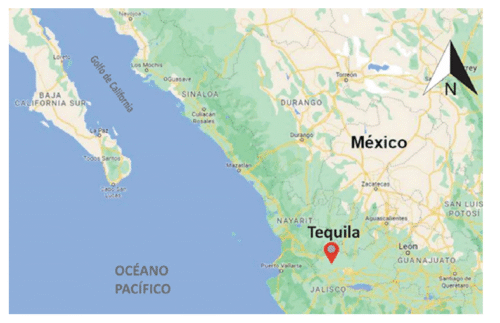
Fig. 1 Location of the study area. Note: The study area includes the municipal head of Tequila, Jalisco, Mexico. Elaboration from Google Maps®
44,353 inhabitants, the result of the 2020 Population and Housing Census of the National Institute of Statistics, Geography and Informatics [12], its demographic composition is configured with 50.6% women and 49.4% men. Most of the population is located in the plains, forming an urban sprawl.
Tequila, Jalisco, is a destination in Mexico that has received different appointments that highlight its tourism potential, the first being MT in 2003 and in July 2006, it was listed as a World Heritage Site [4], thanks to its agave landscape and old industrial facilities. For the year 2016, it obtained the distinction of STD in Progress by the State Mercantile Society for the Management of Innovation and Tourism Technologies (SEGITTUR), seeking to be a different and innovative destination with the implementation of technologies in the tourism sector and expanding coverage. Wi-Fi access throughout the destination, among other strategies [31].
Additionally, Tequila, Jalisco is the first Magical Town in Mexico that has imple- mented the STD model, which implies that this tourist destination must harmonize a complex system with an infinite number of interactions, alliances, and actors, as well as managing the times of the resolution of actions to strengthen both seals of distinction, being a Magical and Intelligent Town. The organizations that have partic- ipated in this transformation process towards a STD are the government of Jalisco, the Ministry of Tourism, the JB Group, the Tequila Integral Development Council (CODIT) and the Ministry of Energy, Tourism and Digital Agenda of Spain. The following are mentioned among the initiatives included in the Tequila Strategic Plan for its transformation into STD. In 2016, a first phase was carried out, in which the process transformation and optimization office was implemented; in addition to considering the user experience and the city brand through ICT; Subsequently, the Smarter City enabling Information Technology platform was implemented, which included Information Technology infrastructure and Wi-Fi, the Intelligent Operations Center Platform and the City Cloud. From 2016 to 2020, the second phase was devel- oped, where the citizen sensor, e-government, intelligent water and drainage manage- ment, intelligent management and asset management were implemented. Achieving in 2018, its denomination as “Pueblo Mágico Inteligente Tequila”. Tequila’s expec- tations to become a Smart City are included in phase three, which is projected to take place from 2020 to 2040. This phase includes the following initiatives: multi-mode transportation, intelligent traffic control, health system environment, personal health index and smart buildings [4].
In the year 2020, Tequila, Jalisco was evaluated again under the SEGITTUR model, as a result, in 2021 this magical town obtained the renewal of its distinctive as STD and reached level 2 in the STD Network. Among the main initiatives that Tequila presents as STD, the following stand out: (1) The destination has a solid and inclusive public–private management structure, materialized in the Tequila Integral Development Council (CODIT), which allows coordination and continuity to the development plans of the destination. (2) There is a strong commitment and key involvement of private investment in projects related to Tequila tourism. (3) One of the areas in which they have made the most progress is in the incorporation of innovative systems for data management and the development of a Smart Tourism Destination Master Plan. (4) Additionally, the private sector is promoting the diversification of demand and supply through the development and structuring of an innovative, differentiated and quality product. (5) From the public and private initiative, the creation and strengthening of the business fabric of Tequila is encouraged through the promotion of local entrepreneurship. (6) Tequila bases its attractiveness on its main tourist resources, whose development is accompanied by conservation policies and improvement of the cultural and natural heritage [29].
4.2 Tequila Tourist Offer
Tequila’s tourist offer includes the attractions, products, support infrastructure and complementary services arranged for the enjoyment and consumption of tourists and visitors, including three and 4-star accommodations, tequila factories and distilleries, historical monuments, tours and tours of the attractions of the destination and its surroundings.
Following Saiz-Alvarez [22], the offer in Tequila, Jalisco, mainly concentrates on the agave landscape that characterizes the destination. Likewise, it has industrial facilities classified as a World Heritage Site by UNESCO (United Nations Educa- tional, Scientific and Cultural Organization) within the Cultural Landscapes category since 2006.
SECTUR [23] points out as attractions of this MT the privileged natural envi- ronment due to its location and the diversity of rivers and streams, in addition to the destination’s historical and cultural places such as the National Tequila Museum, the José Cuervo La Rojeña farm and distillery, the parish of Santiago Apóstol, the laun- dries, the Quinta Sauza and the sanctuary of the Holy Cross. Among the activities promoted are adventure, extreme sports, ecotourism and sport fishing. Also, in this MT, handicrafts that allude to agave and tequila production are made, in addition to manufacturing clay objects. The festivities are the cultural week from April 1 to 15, the celebration of the Day of the Holy Cross every year on May 3, in which pilgrim- ages are made to the Sanctuary of the Cross and the National Fair of the Tequila during November and December.
Regarding the supply of lodging establishments, according to Gauna [7], Tequila, Jalisco does not present significant growth in its hotel offer during 2012 and 2016, from 22 establishments to 27, respectively, however, it is the MT of the state that registers the highest number of visitors. According to the author, the preceding is due to the fact that people decide to use second-home homes, so a part of the people who arrive at this destination is included in this lodging mechanism, and others only do so for one day without spending the night.
Tequila’s tourist offer was analyzed using two indicators: (1) lodging establish- ments and (2) rooms and lodging units. The results of the analysis of the lodging establishments offered by this tourist destination during the period from 2007 to 2019 reflected an upward trend, with an increase of 1.30 establishments per year (Fig. 2). Regarding the supply of rooms and lodging units in Tequila, an upward trend was also observed, with an increase of 27 additional rooms per year, from 2007 to 2019
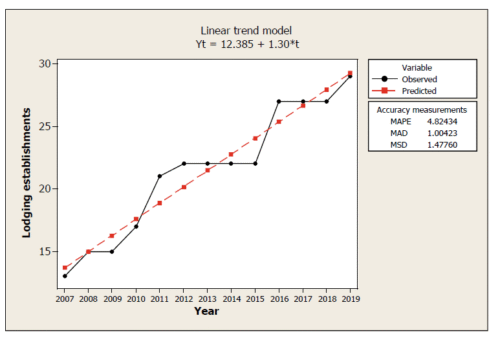
Fig. 2 Trend in the offer of lodging establishments in Tequila, Jalisco, Mexico (2007–2019). MAPE (Mean Absolute Percentage Error), MAD (Mean Absolute Deviation), MSD (Mean Squared Deviation)
Furthermore, it was identified that during the said period, there were marked increases in the years 2011 and 2016, while in the period from 2012 to 2015, there was no growth in supply (Fig. 3).
4.3 Tequila Tourist Demand
Since he was appointed MT, the tourist demand for Tequila has increased signifi- cantly with the arrival of both tourists and transit visitors. According to the Tourism Statistical Yearbook, in 2018, the town received a total of 91,590 tourists, which meant a growth rate of 4.8% from the previous year [27]. Figure 4 shows the arrival of national and foreign tourists from 2007 to 2018.
An upward behaviour is observed in the last four years, after two very marked falls in 2010 and 2014. The composition of the demand is made up of national and international tourism; the first represents 90.2%, while 9.8% corresponds to tourism foreigners visiting the destination. Regarding the reason for the trip, national and foreign tourists, state leisure and recreation as the main one, with 82.4%. The number of transit visitors who enjoy this MT is also significant. In 2018, it amounted to 166,990 visitors [27], also contributing to the development of the sector and the recognition of the MT.
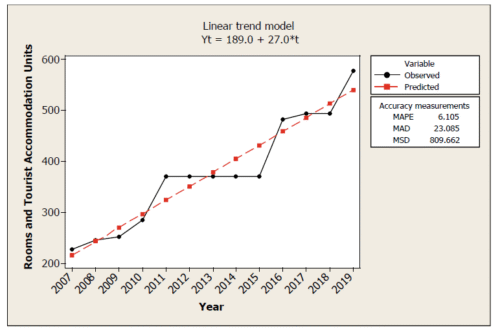
Fig. 3 Trend in the offer of rooms and tourist accommodation units in Tequila, Jalisco, Mexico (2007–2019). MAPE (Mean Absolute Percentage Error), MAD (Mean Absolute Deviation), MSD (Mean Squared Deviation)
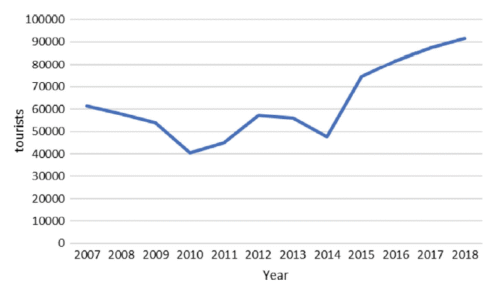
Fig. 4 Arrival of national and foreign tourists to Tequila, Jalisco, Mexico (2007–2018). Source:
Own elaboration based on Statistical Yearbooks 2007–2018, SECTURJAL
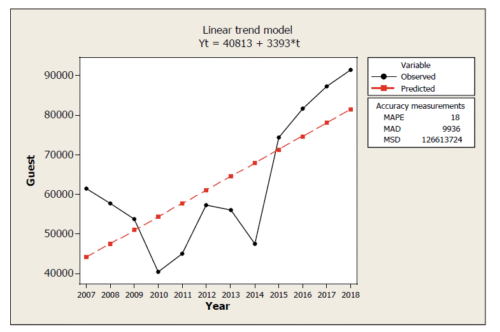
Fig. 5 Trend in accommodation of national and foreign tourism in Tequila, Jalisco, Mexico (2007– 2019). MAPE (Mean Absolute Percentage Error), MAD (Mean Absolute Deviation), MSD (Mean Squared Deviation)
The results obtained when analyzing the demand for Tequila during the period studied reflected an upward trend, with an increase of 3,393 tourists staying per year. Regarding the national demand for hosted tourists, an increasing trend was found throughout the period analyzed. However, decreases were seen in 2010 and 2014, with a significant increase in 2015, remaining constant until 2018. On the other hand, it was found that the demand for foreign tourists remained constant until 2015 when a slight growth was identified that continued without variations during the years analyzed (Fig. 5).
When analyzing the means of information used by both national and foreign tourists to learn about this tourist destination, the following results were observed: (1) National tourists during the period 2007–2019 found out about this destination in the first place through the family and/or friends, then they already knew the destination, and thirdly they used mass media. (2) Among the means of information used by foreign tourists are, firstly, family and/or friends. Secondly, the mass media and thirdly, the internet (Fig. 6). It is important to highlight that the means of information that coincide in both types of tourists and in the first three places of use are the mass media.
Figure 7 shows the trend in the searches carried out by netizens around the world about Tequila (town in Mexico), using the word <<travel>> as a search category. The graph shows the searches carried out between 2004 and June 2021, which reflects
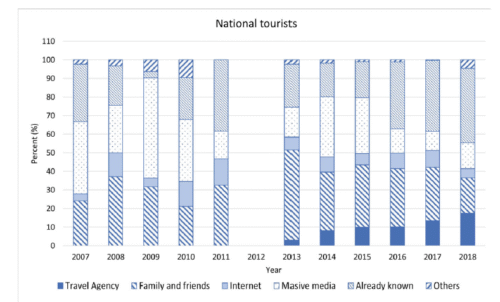
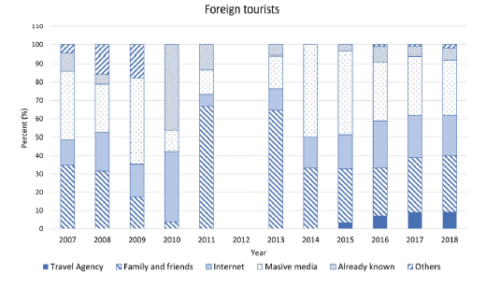
Fig. 6 Information’s sources over Tequila, Jalisco, Mexico used by tourist (2007–2019)
a high temporal cyclical behavior, especially in the first three years, and later from 2015 to 2021, with an upward trend.
Figure 8 shows the trend in searches carried out by netizens around the world about Tequila (town in Mexico), using <<Hotels and accommodation>> as the search category. The graph shows the behavior of the searches carried out from 2004 to June 2021, presenting higher variations from 2004 to 2006, then it presented constant
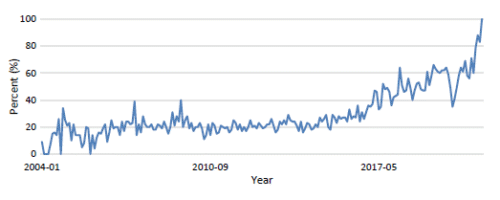
Fig. 7 Trend of searches by internet users from all over the world about Tequila, in the category: Travel (2004–2021)
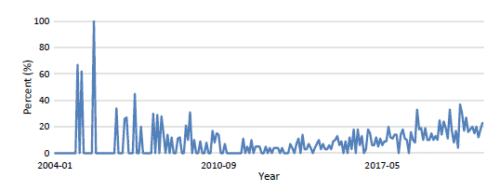
Fig. 8 Trend of searches by internet users from all over the world about Tequila, in the category: Hotels and accommodation (2004–2021) movements until 2018. After this date, they began to rise once again, the number of searches worldwide for this tourist destination.
As part of the effects of the implementation of the STD model in Tequila, Jalisco, improvements were identified in the physical image of the town center, power lines were hidden, integration of street furniture and bilingual signage, wide sidewalks with trees, lighting of church façades and arcades of the first square of the city. In the second phase, the destination improvement consisted of the construction of accommodation, renovation of the main access, expansion of the access road, promotion of tourism and organization of merchants [4].
As a result of the analysis of the tourist offer of Tequila, Jalisco, three periods were evidenced. During 2007–2011 the destination presented an increase in its offer, while in 2011–2015, it did not present growth, restarting the positive trend between 2015 and 2016 in a sustained manner until 2019. In tourism demand, a behavior similar to that of supply was observed, except in 2007–2010, where the trend showed an opposite behavior. Concerning the search trend of netizens from around the world about Tequila, in the travel category, it was observed that it remained constant during the period 2007–2014. As for the tourism indicators, from 2015–2016, there was an exponential increase. On the other hand, the trend of internet searches in the lodging category registered a positive change from the same years 2015–2016. In such a way that the indicators studied on the tourist supply and demand of MT-Tequila, as well as the use of the internet for tourism, registered positive changes from the years 2015–2016, which can be attributed to the fact that in that period, said Magical Town obtained its certification as STD.
3.4 Discussion
Although some research can be consulted regarding the importance and use of ICT as a smart tourism resource [1, 17], the digital tourist experience [6, 36] and innovation that involves the use of ICT in the tourism sector [2, 32], it is possible to deepen in specific case studies and in the process of evolution of the sector, which entails the formation of a Smart Tourism Destination.
Regarding the tourist experiences, the research carried out by Wang et al. [36] in which they explore the relationship between environmental stimuli and tourist experiences to contribute to the background of these smart destinations. The results revealed that physical and psychological stimuli positively affect the experience, so destinations must effectively integrate tourist facilities and virtual spaces to satisfy tourists with the support of technology. However, regarding the case study of this document, no research was found that addresses the tourist experience.
García et al. [6] reviewed how the tourist’s shopping trip can be improved by offering digital information sources to generate purchase expectations and help decision-making. The authors highlight the cognitive, affective and normative dimen- sions as factors that influence the use of ICT for purchasing decisions in a destination. The results obtained in this research are consistent with the published literature since, before the trip, the use of various sources of information is frequent to know the offer and attractions of the destination.
Comparing the results obtained in this investigation with what was expressed by Celdrán-Bernabeu et al. [2], the importance of ICT in the innovative development of tourist destinations can be corroborated. The authors state that using the Internet and ICT can generate an innovative ecosystem supported by better management of the city’s infrastructures and services. Furthermore, when analyzing the results on the information media used by national and international tourists to learn about the Tequila tourist destination, it was possible to verify that the use of the mass media and the internet are among the first three places.
According to Arenas et al. [1], the use of ICT helps develop the key capacities necessary to create a smart tourism ecosystem in tourist destinations, regardless of the origin of said technological resources. When comparing this information with the results obtained in the present investigation regarding the information media used by national and international tourists to get to know Tequila, a coincidence can be observed since the use of ICT was found among the first three media. In this sense and comparing the information of the authors with the results obtained through the analysis of the trend of Internet searches on the tourist destination Tequila, it is observed that there is also a coincidence since the internet is one of the means that they use with potential tourists to plan and carry out their trips more frequently.
Miskalo et al. [17] present the case study of Curitiba, Brazil, and classify this desti- nation as a STD in the development process, according to the dimensions derived from the Invattur model and the “Instituto Universitario de Investigaciones Turís- ticas” of the University of Alicante in Spain. When comparing the above with the results obtained in the present investigation, it can be confirmed that Tequila’s char- acteristics with respect to its tourist supply and demand coincide with those estab- lished in the STD Invattur model. Furthermore, these characteristics correspond to the notable participation of public and private tourism managers in carrying out inno- vative strategies that allowed them to strengthen the economic development of this tourist destination. In this way, it also shows a process of continuous development.
Another case study is shown in the article by Sigalat et al. [32], with the analysis of the transition towards a tourism innovation model of a medium-sized city on the Mediterranean coast through conversion into a Smart Tourism Destination to deter- mine if it meets the requirements for the smart model. In this context, an unavoidable commitment to the environment is assumed, a boost to the local economy and the improvement of citizens’ quality of life. Therefore, innovation plays a very impor- tant role in the tourism sector and is linked to information technologies. This study highlights that ICTs have transformed the operation of the tourism sector through the intensification of their use in the organization, processes and tourism products, as well as the demand of tourists. This dynamic coincides with the tourist operation of Tequila, since the results show that the search for information has increased in recent years, and with it, the purchase of trips to the destination.
The results make it possible to identify a specific period from 2012 to 2015 where the destination does not present significant growth in its hotel offer. The same statement is corroborated by the theory analyzed within the study of Gauna [7], where the author considers the years from 2012 to 2016 and ensures that people decide to use second residences during these years. The effect was that some people who arrived in Tequila, Jalisco, during this time chose this lodging mechanism, so the rooms and lodging units were not reflected in the statistics.
5 Conclusions
In a globalized and competitive context, tourist destinations need to develop and implement innovative and sustainable strategies to achieve the best results in the sector, benefit the local population by improving their quality of life and provide significant experiences for tourists, thus pay according to the objective of the STD about the combination between sustainability and the use of technologies to bring benefits to locals and tourists. Furthermore, technology has significantly impacted the tourist’s travel cycle, and the STDs provide the tools and strategies to improve the efficiency of the services provided at the destination and interact directly with tourism actors.
Considering the recommendations of SEGITTUR, the implementation of the STD model in Tequila, Jalisco, is constantly improving with the strengthening of the tourism plant in recent years. The increase in demand from tourists and travelers in transit to the destination evidences the incorporation of activities and tours in the different seasons. However, all the dimensions determined in the STD model must be more widely met, as well as the full adoption of relevant technological strategies for information management and management of programs focused on improving the quality of life of the local population.
Without failing to consider that the management of a STD is a collective task that implies the participation of both the government and the institutions, tourism companies and the inhabitants of the MT as a whole, coupled with the intervention of the tourist as the main actor, who experiences and enjoy the destination with the use of technology.
The Magical Towns promote the preservation of cultural traditions in Mexico; in contrast, the STDs apply technological and non-technological management strategies that contribute to improving the quality and competitiveness of tourist destinations. Tequila, Jalisco, can offer both benefits by combining the historical and cultural attributes of the place with the sustainability, governance, accessibility, innovation and technology of a STD. Therefore, it is concluded that implementing the STD management model in MT-Tequila, Jalisco in 2016, could be one of the causes that positively influenced the increase in tourism indicators and search trends studied in this research.
References
- Arenas, A.E., Goh, J.M., Urueña, A.: How does IT affect design centricity approaches: evidence from Spain’s smart tourism ecosystem. Int. J. Inf. Mana. 45, 149–162 (2019). https://doi.org/ 1016/j.ijinfomgt.2018.10.015
- Celdrán-Bernabeu, M.A., Mazón López, J.N., Giner Sánchez, D.: Open Data y turismo. Implicaciones para la gestión turística en ciudades y destinos turísticos inteligentes. Revista Investigaciones Turísticas 15, 49–78 (2018). https://doi.org/10.14198/inturi2018.15.03
- Cruz Vicente, M.Á., Agatón Lorenzo, D., Añorve Fonseca, N.N.: El Turismo de Naturaleza en la zona turística de Pie de la Cuesta en Acapulco Guerrero, México: Caminando hacia un espacio turístico inteligente, los primeros In U. N. A. de M. y A. M. de C. para el D. R.
A.C (Ed.), Desarrollo regional sustentable y turismo, pp. 699–723 (2018)
- De Arteaga, : Tequila Inteligente. Secretaría de Turismo (2018)
- EU: Compendium of best practices. 2019 European Capital of Smart Tourism competition, I (2019)
- García, A., Juaneda, E., Olarte, C., Pelegrín, J.: Towards the smart tourism destination: key factors in information source use on the tourist shopping journey. Tourism Manag. Perspect. 36, 1–9 (2020). https://doi.org/10.1016/j.tmp.2020.100730
- Gauna, C.:( Análisis sociodemográfico y turístico de los “Pueblos Mágicos” de Jalisco, México. El Periplo Sustentable, 34–66 2019)
- Guillén Lúgigo, : El programa Pueblos Mágicos y algunos de sus efectos locales. Dimensiones Turísticas 5(8), 131–141 (2021). https://doi.org/10.47557/mjcu3028
- Hernández-Sampieri, R., Fernández, C. & Baptista, P.: Metodología de la investigación (6a ). McGraw-Hill (2014)
- Iglesias, T., García, B., Fernández, A.: Los destinos turísticos inteligentes dentro del turismo urbano : El caso de León. Estudios Turísticos 216(2o S 2018), 107–132 (2018). https://dialnet. es/servlet/catart?codigo=7042606
- INEGI: Aspectos geográficos. Jalisco (2020). https://www.inegi.org.mx/contenidos/app/areasg eograficas/resumen/resumen_14.pdf
- INEGI: Censo de población y vivienda 2020 (2021). https://www.inegi.org.mx/programas/ ccpv/2020/
- tur: Modelo DTI de la Comunitat Valenciana (2022). https://invattur.es/modelo-destinos- turisticos-inteligentes.html
- TUR.: Destinos turísticos inteligentes. Manual operativo para la configuración de destinos turísticos inteligentes. Agencia Valenciana del Turismo (2015). http://invattur.gva. es/estudio/manual-operativo-para-la-configuracion-de-destinos-turisticos-inteligentes/
- Ivars-Baidal, J.A., Celdrán-Bernabeu, M.A., Femenia-Serra, F., Perles-Ribes, J.F., Giner- Sánchez, : Measuring the progress of smart destinations: The use of indicators as a manage- ment tool. J. Destination Market. Manag. 19 (2021). https://doi.org/10.1016/j.jdmm.2020. 100531
- López de Ávila, A., Lancis, E., García, S., Alcantud, A., García, B., Muñoz, N.: Informe destinos turísticos inteligentes: construyendo el futuro. Segittur (2015). http://www.thinktur. org/media/Libro-Blanco-Destinos-Tursticos-Inteligentes-construyendo-el-futuro.pdf
- Miskalo, M., Goncalves, J., Dias, D., Molteni, A.: CURITIBA (BRASIL) ¿UN DESTINO TURÍSTICO INTELIGENTE? Análisis de la percepción de los miembros del Concejo Municipal de Turismo (COMTUR). Estudios y Perspectivas En Turismo 29(2), 450–471 (2020)
- OECD: OECD tourism trends and policies 2018 (Vol. 48, Issue 01). OECD Publishing (2018). https://doi.org/10.1787/tour-2018-en
- OMT: Barómetro OMT del Turismo Mundial, Anexo estadístico, Enero 2020. Barómetro OMT Del Turismo Mundial 18(1), 1–48 (2020). https://doi.org/10.18111/wtobarometeresp. 18.1.1
- Piñón González, M.A., Castillejos López, B.: Huatulco desde la perspectiva de los destinos Turismo y Sociedad 25, 73–92 (2019). https://doi.org/10.18601/01207555.n25.04
- Rodríguez, : Métodos de investigación. Diseño de proyectos y desarrollo de tesis en ciencias administrativas, organizacionales y sociales (1a. Edició). Universidad Autónoma de Sinaloa (2010)
- Saiz-Alvarez, J.M.: Turismo sostenible y emprendimiento social. El pueblo mágico de Tequila, México. Retos. Revista de Ciencias de La Administración y Economía 8(15), 51–67 (2018). https://doi.org/10.17163/ret.n15.2018.04 Recibido:
- SECTUR: Tequila, Jalisco, México (2014). http://www.sectur.gob.mx/gobmx/pueblos-mag icos/tequila-jalisco/
- SECTUR: Visión Global del Turismo a México. Análisis de mercados, perspectivas del turismo Enero-Abril de 2018. Secretaria de Turismo (2018). https://www.datatur.sectur.gob. mx/Documentoscompartidos/VisionGlobalTurismoAMexAbr2018.pdf
- SECTUR: Estrategia Nacional de los Pueblos Mágicos (2020a). http://sistemas.sectur.gob.mx/ pueblosmagicos/formatos/ENPM.pdf
- SECTUR: Resultados de la Actividad Turística. Enero (2020b)
- SECTURJAL: Anuario Estadístico de Turismo del Estado de Jalisco 2018 (2018). https://sec jalisco.gob.mx/invierte-en-jalisco/estadisticas
- Segittur: ¿Qué es el modelo DTI? (2022a). https://www.destinosinteligentes.es/que-es-dti/
- Segittur: Tequila (México) DTI (2022b). https://www.destinosinteligentes.es/destinos/tequila- mexico-2/
- SEGITTUR: Destinos Turísticos Inteligentes (2022). https://www.destinosinteligentes.es/des tinos-inteligentes/
Effects of the Implementation of the Smart Tourism Destination Model … 19
- SEGITTUR: La estrategia Española de Destinos Turísticos Inteligentes. Jornadas Europeas. Sostenibilidad y Territorios Inteligentes, 40 (2018)
- Sigalat, , Calvo, R., Roig, B., García, I.: Transition towards a tourist innovation model: The smart tourism destination Reality or territorial marketing? J. Innov. Knowl. 5, 96–104 (2020). https://doi.org/10.1016/j.jik.2019.06.002
- SINED: Ciclo de videoconferencias: Aprendiendo de los Pueblos Mágicos (p. 60). SINED, SEP, ANUIES, U de COLIMA, CEUPROMED (2013)
- UNWTO: World Tourism World Tourism Barometer 19(1), 42 (2021). https://doi. org/10.18111/wtobarometereng.2021.19.1.1
- Valverde, C., Benavides, M.: El turismo en México. Una visión hacia el futuro. Planur-E 9, 1–15 (2017)
- Wang, , Xie, C., Qiaowen Huang, Q., Morrison, A.: Smart tourism destination experiences- the mediating impact of arousal levels. Tourism Manag. Perspect. 35, 1–11 (2020). https://doi. org/10.1016/j.tmp.2020.100707
